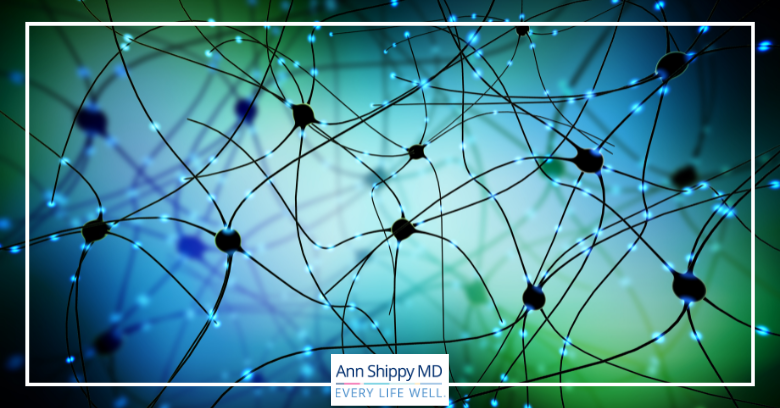Dopamine – New Secrets Revealed
Neurotransmitters are chemical messengers critical for the functioning of the nervous system and the behaviors we engage in daily. Dopamine is our “feel good” neurotransmitter and helps us experience pleasure, focus, motivation, and happiness.
We are learning more about dopamine all the time. For example, like serotonin, not all dopamine is produced in the brain; the gut plays a leading role.
And new research reveals how dopamine is taken back up into cells with the DAT transmitter, where it can be reused.
Today’s article will dive into this latest discovery.
Keep reading to learn more about:
- What is dopamine?
- What happens when dopamine is too low or too high?
- What the new DAT research reveals
- How to increase and balance dopamine levels, naturally
What Is Dopamine?
Dopamine is often referred to as the “feel good,” happiness, or pleasure neurotransmitter. It’s synthesized from the amino acid tyrosine and facilitates communication between brain nerve cells and communication between the brain and body.
It’s found in the central and peripheral nervous systems, including the enteric nervous system in the gut. Certain bacteria in the gut microbiome make dopamine.
Dopamine acts on the brain’s reward center. Neurotransmitters are released in the synapse, the space between two nerve cells. When you do something that feels good, like go for a run or receive an email from a friend, the synapse floods with dopamine.
Then dopamine binds to receptors on the adjacent nerve cell, causing you to feel pleasure. Finally, the cell that released the dopamine pulls the dopamine back in. It can be reused next time.
Dopamine also has hormone-like actions in the body. It’s a member of the catecholamine family, like epinephrine (adrenaline) and is released into the bloodstream.
Dopamine has evolved as a reward when you engage in activities needed for survival. The feel-good, pleasurable feeling it elicits motivates you to do more of that thing and get more of that good feeling. It reinforces the behavior.
Dopamine has many actions in the body and plays a crucial role in:
- Movement and motor skills
- Motivation
- Cognition
- Attention
- Mood
- Learning
- Memory
- Pleasure
- Sleep
- GI motility
- Blood pressure
- Lactation
- Immunity
When dopamine is out of balance, you feel it throughout the body, not just the brain.
Low Vs. High Dopamine
Symptoms related to low dopamine include:
- Hopelessness
- Low stress resilience
- Easily distracted; hard to focus
- Low libido
- Low motivation
- Memory loss
- Fatigue
- Mood changes
- Sleep disruption
Low dopamine is a factor in depression, ADHD, and Parkinson’s disease.
A temporary high level of dopamine as part of the pleasure and reward system may give us a feeling of happiness, motivation, and euphoria. But high dopamine can have a dark side.
High levels of dopamine are related to:
- Aggression
- Poor impulse control
- Addiction
It’s easier for some people to get addicted to the pleasure of dopamine.
The dopamine response helps to explain why sugar and other hyperpalatable foods can be addictive. They give us a dopamine rush and leave us wanting that feeling again so we go back for more.
Dopamine also plays a role in addictions to gambling, shopping, and drugs such as cocaine.
Dopamine and DAT
Dopamine transporter, or DAT, is the protein that pulls dopamine out of the synapse and back into the nerve cell like a vacuum. DAT is essential for regulating dopamine levels, and it controls the intensity of dopamine signaling.
When DAT brings dopamine back into the cell, it can be reused without using resources to break down dopamine or synthesize more dopamine. It’s quite efficient.
DAT is a sodium-coupled neurotransmitter transporter, much like serotonin, norepinephrine, and GABA transporters.
As its name suggests, we have long known that dopamine uptake relies on sodium and how sodium is involved in nerve conduction.
However, new research from the University of Copenhagen suggests that potassium is also critical, as it is in the serotonin transporter (SERT).
The key finding is that potassium increases dopamine uptake by DAT. This discovery is critical for discovering new treatments for disease.
Current medications for ADHD block DAT, so the dopamine signal continues as dopamine stays in the synapse.
Cocaine, for example, completely blocks DAT, so no dopamine returns to the cell, leading to the need for more cocaine and eventually depletion of dopamine levels since it isn’t being reused by the cell.
New medications could focus on regulating DAT and potassium instead of blocking DAT. This approach may lead to more effective treatments for drug addiction, ADHD, schizophrenia, and other diseases where dopamine plays a role.
How To Boost Dopamine, Naturally
Since most of us want more of that pleasurable dopamine feeling, here are some suggestions for supporting healthy dopamine levels in the body. Please work with your Functional Medicine doctor for personalized guidance, especially if you are experiencing depression or addiction.
- Get tested. While we can’t test the dopamine levels in the synapse or nerve cells themselves, we can look at dopamine metabolites in the blood or urine. This testing may help assess neurotransmitter levels and brain health. In our DIY Testing, you’ll find dopamine markers as part of the organic acids test (OAT) and the DUTCH hormone test.
- Increase protein. Make sure you have enough tyrosine in the diet so it can be used to make dopamine. You’ll find tyrosine in these Paleo foods: eggs, grass-fed beef, fish, poultry, pork, avocado, and pumpkin seeds.
- Dial in micronutrients. In addition to tyrosine, making dopamine requires these essential cofactors: vitamin B6, folate, niacin, and iron. In addition to a protein-rich diet, eat a variety of colorful fruits and vegetables and daily dark leafy greens. Adding in a high-quality multivitamin is a good insurance policy.
- Don’t forget electrolytes, especially potassium. Sodium and potassium are important electrolyte minerals, and both play a role in proper dopamine signaling and uptake via DAT. Be sure to use a quality sea salt when cooking and include high potassium foods such as bananas, sweet potatoes, and avocados in the diet. Electrolyte Reload is our go-to for electrolyte powder.
- Support gut health. Improving and restoring gut health supports brain health and mood! Beneficial microorganisms produce dopamine when the microbiome is in balance. A daily probiotic supplement is also helpful.
- Get moving. Ever notice that rush of endorphins and happiness from a good workout? Well, exercise supports dopamine production and healthy dopamine levels. Work on making exercise a regular part of your routine and notice how it lifts your mood.
- Then, rest. DAT fluctuates across the sleep-wake cycle, and we can support it by creating good sleep habits and getting enough sleep each night. Check out these tips for better sleep.
- Build happiness habits. We all have certain practices that help us feel happy. It could be yoga, mindfulness, meditation, time in nature, journaling, listening to music, and many more dopamine-supportive options. Notice what health-promoting habits boost your motivation, pleasure, and happiness. Then, do more of those.
The balance of dopamine and DAT is not only important for survival, but it helps us to thrive and enjoy life.
When dopamine is low or high, we feel the effects in our daily behaviors, patterns, and mood. But dopamine isn’t set in stone, the nutrition and lifestyle factors discussed here may be just what your brain needs.
References
- https://www.ncbi.nlm.nih.gov/pmc/articles/PMC8116345/
- https://www.ncbi.nlm.nih.gov/pmc/articles/PMC4259177/
- https://www.ncbi.nlm.nih.gov/pmc/articles/PMC4515538/
- https://www.ncbi.nlm.nih.gov/pmc/articles/PMC6842680/
- https://pubmed.ncbi.nlm.nih.gov/29142296/
- http://www.sciencedaily.com/releases/2022/05/220518101746.htm
- https://www.ncbi.nlm.nih.gov/pmc/articles/PMC9068915/
- https://www.ncbi.nlm.nih.gov/pmc/articles/PMC8026992/
- https://www.ncbi.nlm.nih.gov/pmc/articles/PMC8962300/
- https://www.ncbi.nlm.nih.gov/pmc/articles/PMC8316543/













